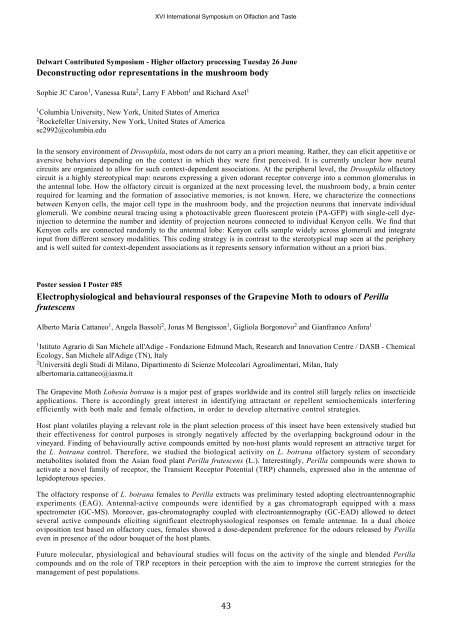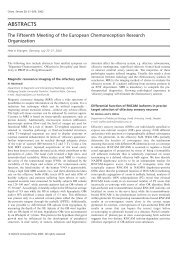XVI International Symposium on Olfaction and Taste - ecro
XVI International Symposium on Olfaction and Taste - ecro
XVI International Symposium on Olfaction and Taste - ecro
Create successful ePaper yourself
Turn your PDF publications into a flip-book with our unique Google optimized e-Paper software.
<str<strong>on</strong>g>XVI</str<strong>on</strong>g> <str<strong>on</strong>g>Internati<strong>on</strong>al</str<strong>on</strong>g> <str<strong>on</strong>g>Symposium</str<strong>on</strong>g> <strong>on</strong> Olfacti<strong>on</strong> <strong>and</strong> <strong>Taste</strong><br />
Delwart C<strong>on</strong>tributed <str<strong>on</strong>g>Symposium</str<strong>on</strong>g> - Higher olfactory processing Tuesday 26 June<br />
Dec<strong>on</strong>structing odor representati<strong>on</strong>s in the mushroom body<br />
Sophie JC Car<strong>on</strong> 1 , Vanessa Ruta 2 , Larry F Abbott 1 <strong>and</strong> Richard Axel 1<br />
1 Columbia University, New York, United States of America<br />
2 Rockefeller University, New York, United States of America<br />
sc2992@columbia.edu<br />
In the sensory envir<strong>on</strong>ment of Drosophila, most odors do not carry an a priori meaning. Rather, they can elicit appetitive or<br />
aversive behaviors depending <strong>on</strong> the c<strong>on</strong>text in which they were first perceived. It is currently unclear how neural<br />
circuits are organized to allow for such c<strong>on</strong>text-dependent associati<strong>on</strong>s. At the peripheral level, the Drosophila olfactory<br />
circuit is a highly stereotypical map: neur<strong>on</strong>s expressing a given odorant receptor c<strong>on</strong>verge into a comm<strong>on</strong> glomerulus in<br />
the antennal lobe. How the olfactory circuit is organized at the next processing level, the mushroom body, a brain center<br />
required for learning <strong>and</strong> the formati<strong>on</strong> of associative memories, is not known. Here, we characterize the c<strong>on</strong>necti<strong>on</strong>s<br />
between Keny<strong>on</strong> cells, the major cell type in the mushroom body, <strong>and</strong> the projecti<strong>on</strong> neur<strong>on</strong>s that innervate individual<br />
glomeruli. We combine neural tracing using a photoactivable green fluorescent protein (PA-GFP) with single-cell dye-<br />
injecti<strong>on</strong> to determine the number <strong>and</strong> identity of projecti<strong>on</strong> neur<strong>on</strong>s c<strong>on</strong>nected to individual Keny<strong>on</strong> cells. We find that<br />
Keny<strong>on</strong> cells are c<strong>on</strong>nected r<strong>and</strong>omly to the antennal lobe: Keny<strong>on</strong> cells sample widely across glomeruli <strong>and</strong> integrate<br />
input from different sensory modalities. This coding strategy is in c<strong>on</strong>trast to the stereotypical map seen at the periphery<br />
<strong>and</strong> is well suited for c<strong>on</strong>text-dependent associati<strong>on</strong>s as it represents sensory informati<strong>on</strong> without an a priori bias.<br />
Poster sessi<strong>on</strong> I Poster #85<br />
Electrophysiological <strong>and</strong> behavioural resp<strong>on</strong>ses of the Grapevine Moth to odours of Perilla<br />
frutescens<br />
Alberto Maria Cattaneo 1 , Angela Bassoli 2 , J<strong>on</strong>as M Bengtss<strong>on</strong> 1 , Gigliola Borg<strong>on</strong>ovo 2 <strong>and</strong> Gianfranco Anfora 1<br />
1Istituto Agrario di San Michele all'Adige - F<strong>on</strong>dazi<strong>on</strong>e Edmund Mach, Research <strong>and</strong> Innovati<strong>on</strong> Centre / DASB - Chemical<br />
Ecology, San Michele all'Adige (TN), Italy<br />
2Università degli Studi di Milano, Dipartimento di Scienze Molecolari Agroalimentari, Milan, Italy<br />
albertomaria.cattaneo@iasma.it<br />
The Grapevine Moth Lobesia botrana is a major pest of grapes worldwide <strong>and</strong> its c<strong>on</strong>trol still largely relies <strong>on</strong> insecticide<br />
applicati<strong>on</strong>s. There is accordingly great interest in identifying attractant or repellent semiochemicals interfering<br />
efficiently with both male <strong>and</strong> female olfacti<strong>on</strong>, in order to develop alternative c<strong>on</strong>trol strategies.<br />
Host plant volatiles playing a relevant role in the plant selecti<strong>on</strong> process of this insect have been extensively studied but<br />
their effectiveness for c<strong>on</strong>trol purposes is str<strong>on</strong>gly negatively affected by the overlapping background odour in the<br />
vineyard. Finding of behaviourally active compounds emitted by n<strong>on</strong>-host plants would represent an attractive target for<br />
the L. botrana c<strong>on</strong>trol. Therefore, we studied the biological activity <strong>on</strong> L. botrana olfactory system of sec<strong>on</strong>dary<br />
metabolites isolated from the Asian food plant Perilla frutescens (L.). Interestingly, Perilla compounds were shown to<br />
activate a novel family of receptor, the Transient Receptor Potential (TRP) channels, expressed also in the antennae of<br />
lepidopterous species.<br />
The olfactory resp<strong>on</strong>se of L. botrana females to Perilla extracts was preliminary tested adopting electroantennographic<br />
experiments (EAG). Antennal-active compounds were identified by a gas chromatograph equipped with a mass<br />
spectrometer (GC-MS). Moreover, gas-chromatography coupled with electroantennography (GC-EAD) allowed to detect<br />
several active compounds eliciting significant electrophysiological resp<strong>on</strong>ses <strong>on</strong> female antennae. In a dual choice<br />
ovipositi<strong>on</strong> test based <strong>on</strong> olfactory cues, females showed a dose-dependent preference for the odours released by Perilla<br />
even in presence of the odour bouquet of the host plants.<br />
Future molecular, physiological <strong>and</strong> behavioural studies will focus <strong>on</strong> the activity of the single <strong>and</strong> blended Perilla<br />
compounds <strong>and</strong> <strong>on</strong> the role of TRP receptors in their percepti<strong>on</strong> with the aim to improve the current strategies for the<br />
management of pest populati<strong>on</strong>s.<br />
43



